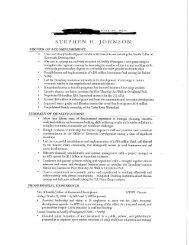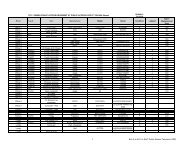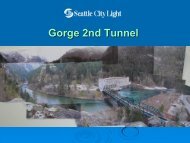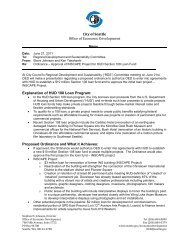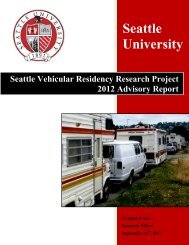2013 Water System Plan, Volume II - Seattle City Clerk's Office - City ...
2013 Water System Plan, Volume II - Seattle City Clerk's Office - City ...
2013 Water System Plan, Volume II - Seattle City Clerk's Office - City ...
You also want an ePaper? Increase the reach of your titles
YUMPU automatically turns print PDFs into web optimized ePapers that Google loves.
Chapter 5 <strong>Water</strong> Infrastructure<br />
most common are the lap-weld, butt-weld, and butt strap joints. Refer to AWWA<br />
Manual M-11 for a photo of each type of joint:<br />
Lap-Weld Joint. In general, SPU prefers a lap-weld joint because they are easy<br />
to install. Lap-welded pipe is a bell and spigot pipe with the bell welded to the<br />
spigot where they overlap. The design engineer can select an interior only weld,<br />
exterior only weld, or double lap weld (interior and exterior). SPU recommends<br />
the double lap weld. It provides an added safety factor at each joint, but can<br />
only be done in larger diameters because it requires a welder to make an<br />
interior weld. Also, each joint can be checked for leakage with an air test. With a<br />
lap-weld joint, small deflections can be made at each joint before welding.<br />
Given the geometry of the double welded lap joint, it experiences twice as much<br />
strain as the pipe wall when post-construction forces (settlement) cause pipe<br />
movement.<br />
Butt-Weld Joint. Butt-weld joints are made by aligning the ends of two pipe<br />
sections and welding at the point of “near-contact” of the two ends. To<br />
complete a butt-weld joint, both ends of the pipe must be the same size. A buttweld<br />
joint is more difficult in the field because the pipes must be near perfectly<br />
aligned. This style weld eliminates the geometric strain that can be induced at a<br />
lap-weld joint. SPU has used butt-welded joints for pipelines designed for higher<br />
levels of seismic loading. The butt-weld joint is also used in horizontal<br />
directional drilling (HDD) applications, where having a bell shape on the pipe is<br />
not recommended. A full penetration butt-welded steel pipe is one of the best<br />
choices for seismic protection.<br />
Butt-Strap Joint. A butt-strap joint consists of a strip of steel that overlaps two<br />
plain end pieces of pipe by several inches. The butt strap is joined to each pipe<br />
by an exterior weld (and an interior weld if the pipes have sufficient diameter).<br />
The two pipe ends do not have to have identical outside diameters, but they<br />
must be relatively similar. Typically, a butt-strap joint is used to join a new steel<br />
pipe to an existing steel pipeline.<br />
SPU follows the recommendations of the American Welding Society (AWS) Structural<br />
Welding Code.<br />
D. Flexible Restrained Joints<br />
Flexible restrained joints allow some deflection and movement of the joint, but restrain<br />
the joint while under pressure. These joints are the standard restrained joints used by<br />
SPU. All ductile iron pipe manufacturers make a boltless restrained joint ductile iron<br />
pipe that uses a restraining ring and locking lugs to restrain joints yet provide flexibility.<br />
Check the manufacturer’s literature because products vary.<br />
The use of flexible restrained joint pipe systems should be used when special site or<br />
system conditions are present and the use of concrete thrust blocks is not appropriate.<br />
Flexible restrained joint pipe systems are required when site/project needs have the<br />
following characteristics:<br />
The water main is to be located in an area of liquefiable soils.<br />
The area is defined to have soils with a poor bearing capacity.<br />
SPU Design Standards and Guidelines<br />
5-27



